If you have a bountiful supply of basil from your garden, it’s important to store it properly to ensure its freshness. Storing basil improperly can lead to wilted, black, and flavorless leaves, which can ruin any dish. Here, we will explore some of the best ways to store basil from your garden and keep it fresh for as long as possible.
Key Takeaways
- Proper storage techniques are essential to keep basil fresh and flavorful.
- Cold storage can quickly turn basil black and mushy.
- Water storage and treating basil like a bouquet of flowers can help maintain its freshness for up to a week.
- Freezing, drying, and making homemade sauces with excess basil can extend its shelf life.
Avoid Refrigeration and Opt for Water Storage
Cold temperatures can cause basil to turn black and mushy, so it’s best to avoid refrigeration. Instead, try water storage to maintain the freshness of your basil. To use this method, trim the ends of the basil stems and place them in a glass jar or vase with water. Cover the basil loosely with a plastic bag and keep it at room temperature. Be sure to change the water every two days to prevent bacteria growth.
Proper basil storage can also involve refrigeration, but it’s important to take steps to prevent moisture buildup. Store the basil leaves in a container or Ziplock bag lined with paper towels to absorb moisture, and then refrigerate them. This will help keep the leaves fresh for up to a week.
For longer-term storage, consider freezing the fresh basil leaves. Start by blanching the leaves in boiling water for a few seconds, then placing them in an ice bath to stop the cooking process. Once dry, transfer the leaves to a freezer-safe container and store them in the freezer.
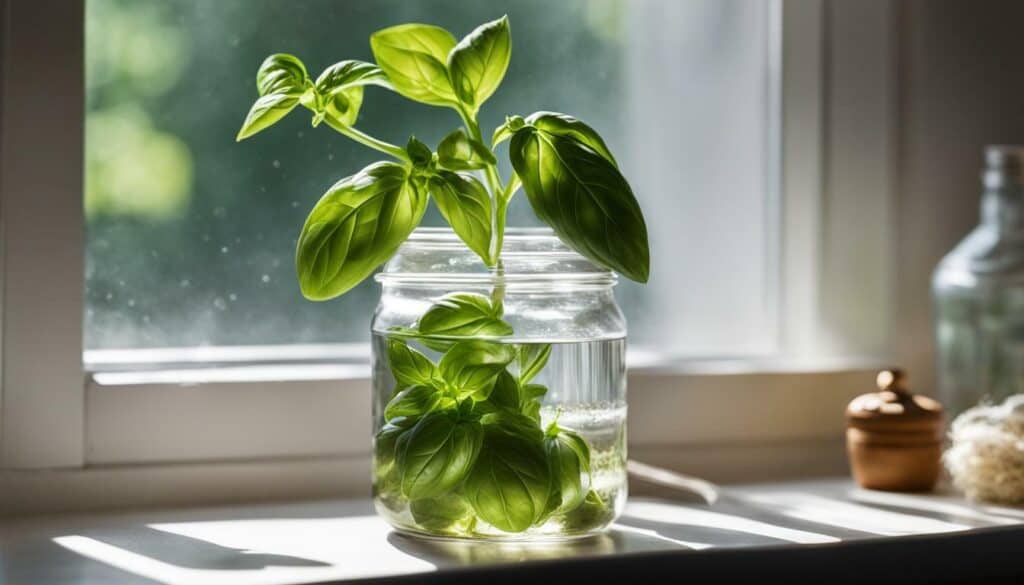
Another freezer-friendly option is to make basil cubes. Simply chop basil leaves and place them in an ice cube tray, cover with olive oil, and freeze. These cubes can then be added to sauces and soups for a burst of basil flavor.
If you have an abundance of basil, consider dehydrating it for long-term use. With a food dehydrator or in the oven on a low heat setting, you can easily dry out the leaves to create dried basil for future cooking.
By using these proper basil storage methods, you can maximize the freshness and flavor of your basil without the need for refrigeration. Experiment with different techniques to find the one that works best for you and your cooking needs.
Maintain Freshness with Water Storage
One recommended method for storing basil leaves is to trim the ends of the stems and place them in a glass jar or vase filled with water. This is because cold temperatures can cause basil to turn black and mushy, making it important to avoid refrigeration. By storing basil in water, you can maintain its freshness and extend its lifespan.
Once you have trimmed the ends of the stems, place the cut basil in the glass jar or vase with water. It’s important to cover the basil loosely with a plastic bag to create a humid environment, but not so tight that air can’t circulate. This will help prevent the basil from drying out.
Changing the water every two days is crucial to keeping the basil fresh. Freshwater helps prevent bacterial growth, which can cause the leaves to wilt and decay. By changing the water regularly, you can extend the lifespan of the basil and ensure that it stays vibrant and flavorful.
Storing trimmed basil in a glass jar or vase with water, covered again loosely with a plastic bag, is another method for maintaining freshness and prolonging the lifespan of the herb. This method is similar to the first, but you have already removed the excess stems, which makes it easier to store the basil and keep it fresh.
Water storage is a simple and effective way to keep basil fresh and flavorful for an extended period of time. Try this method for storing your garden-fresh basil and enjoy its delicious flavor for weeks to come.
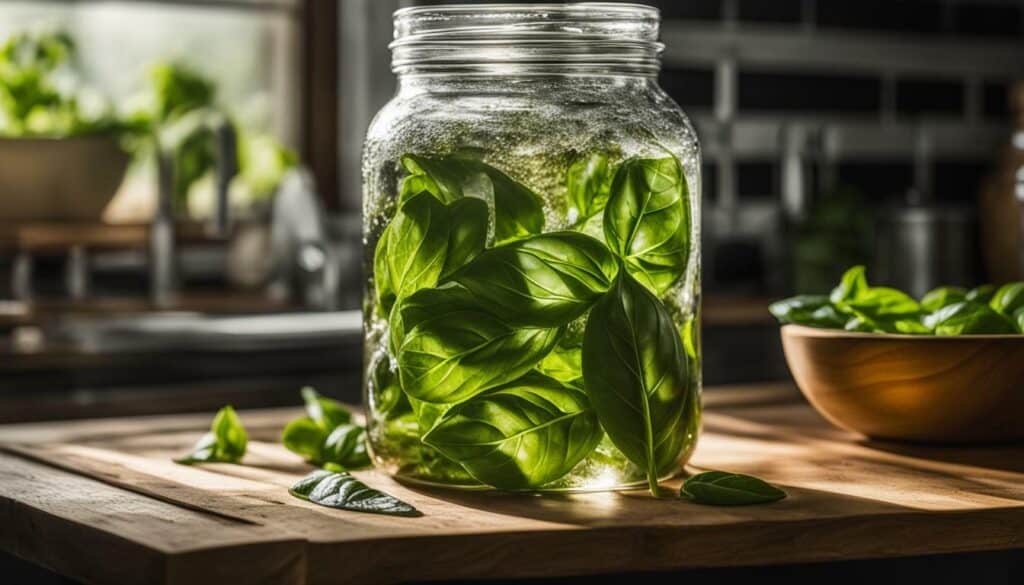
Extend Basil’s Shelf Life with Homemade Sauces
Instead of freezing basil, consider making sauces like pesto or chimichurri to extend the life of the herbs. These sauces are easy to make and can be used to add flavor to various dishes, such as pasta, grilled meats, and salads.
To make a basic pesto sauce, blend fresh basil leaves, garlic, pine nuts, and parmesan cheese in a food processor. Slowly drizzle in olive oil until the mixture reaches a smooth consistency. Transfer the pesto to an airtight container and store it in the refrigerator for up to a week.
For chimichurri, blend fresh basil leaves, parsley, oregano, garlic, red wine vinegar, and olive oil in a food processor. Season with salt and pepper to taste. Transfer the sauce to an airtight container and store it in the refrigerator for up to two weeks.
These sauces can also be frozen for longer storage. Spoon the sauce into ice cube trays and freeze until solid. Once frozen, transfer the cubes to a resealable bag and keep them in the freezer for up to three months. To use, simply thaw the cubes in the refrigerator or at room temperature.
Using homemade sauces not only extends the life of basil but also adds depth and complexity to your meals. With a little creativity, you can experiment with different ingredients and create your own unique sauces that complement your favorite dishes.
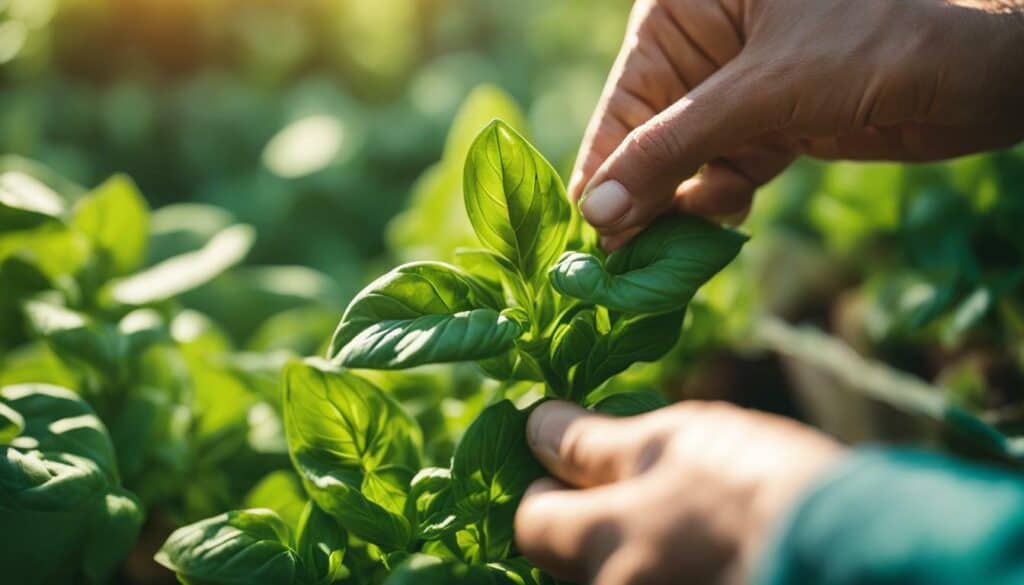
Treat Basil Like a Bouquet of Flowers
Another way to store basil is by treating it like a bouquet of flowers. Unlike other tender herbs like cilantro or dill, basil shouldn’t be stored in the fridge. This is because the cold temperature can cause it to turn black and mushy. Instead, trim the stems of the basil and place them in a glass jar or vase filled with water.
Loosely cover the basil with a plastic bag and keep it at room temperature on your kitchen counter. Changing the water every two days will help keep the basil fresh for up to a week. This way, you can use fresh basil leaves in your favorite dishes without worrying about them losing their vibrant flavor.
If you have an excess amount of basil, freezing it can be a convenient way to preserve it. However, it’s important to note that freezing can cause the basil to lose its vibrant green color, fresh flavor, and tender texture.
To freeze basil, blanch the leaves in boiling water for 10 seconds, then place them in a bowl of iced water to preserve their color. After removing any excess water, arrange the blanched leaves on a cookie sheet and freeze them for 12 hours. Transfer the frozen basil leaves to a freezer-safe bag and store them in the freezer for long-term use.
Another method for storing fresh basil is to treat it like salad greens. After trimming the leaves from the stems, pat them dry or use a salad spinner to remove excess water. Lay the leaves on a paper towel and gently roll them up before placing them in an airtight container or resealable bag in the refrigerator.
If you want a more flavorful option for preserving basil, you can make basil cubes with olive oil. Tear the basil leaves from the stems, wash them, and pat them dry. Roll the leaves up and slice them thinly before placing them in the compartments of an ice cube tray. Slowly pour olive oil into each compartment, making sure the leaves are covered, and freeze the tray. Once frozen, transfer the basil cubes to a resealable bag for long-term storage.
Lastly, if you have an abundance of basil and want to save it for later use, you can dry it. Simply hang the basil bunch upside down in a cool, dry place until the leaves are completely dried. Once dry, remove the leaves from the stems and store them in an airtight container.
By using these methods for storing fresh basil, you can extend its lifespan and enjoy its fresh flavor for longer periods of time. Whether you choose to store it in water, freeze it, treat it like salad greens, make basil cubes, or dry it, these techniques ensure that your basil stays fresh and ready to use in your favorite dishes.

Use Blanching and Freezing for Long-Term Storage
Additionally, you can blanch basil leaves and freeze them for long-term storage. This involves immersing the leaves in boiling water for a few seconds and then transferring them to an ice bath to preserve their green color. Once dried, these leaves can be placed in a freezer-safe bag or container and frozen for future use. A simpler option is to freeze basil in oil using an ice cube tray. This makes it easy to portion out the basil and use it in cooking.
Another option for long-term storage is to dry basil leaves. This method helps preserve the herb and prevent waste. Once dried, the leaves can be easily stored in an airtight container and used as needed.
Using these methods for long-term storage can help extend the lifespan of basil and ensure that it stays fresh for future use. It’s important to note that when freezing basil, it may not retain its fresh flavor and aroma as well as it does when dried. However, it can still be a great option to prevent waste and ensure that you always have basil on hand.
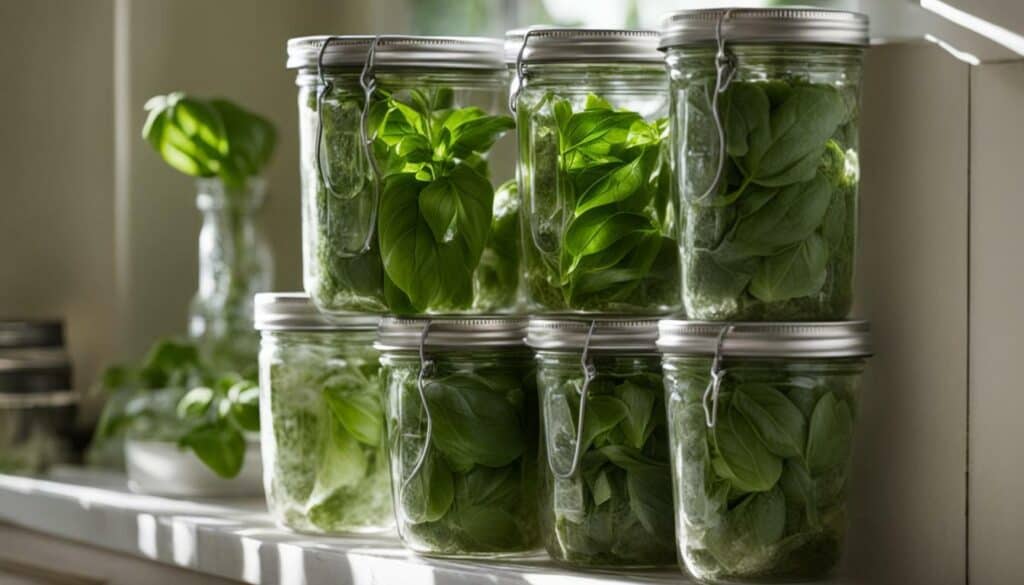
Using Paper Towels and Airtight Containers
Other methods of storing basil include using paper towels to keep the leaves dry and wrapping them in an airtight container in the refrigerator. However, these methods are not the best for storing basil and can actually cause the herb to lose its flavor and nutrients quickly.
When it comes to storing fresh basil for longer periods of time and retaining its freshness, using water storage or homemade sauces is a much better option. For example, you can trim the ends of the basil stems and place them in a glass jar or tall vase with water, then cover the basil with a plastic bag and keep at room temperature. Changing the water every two days will help keep the basil fresh for up to a week or more.
If you prefer to make green sauces, like pesto or salsa verde, puréeing the basil with other herbs and storing them in airtight containers in the fridge can also preserve the herb for an extended period of time. However, freezing basil can cause the leaves to lose their vibrant green color, fresh flavor, and tender texture.
Therefore, if you only have paper towels and airtight containers available, it’s best to use them temporarily until you can transfer your basil to water storage or homemade sauce. If you do choose to use these methods, be sure to pat dry or use a salad spinner to remove excess water from the basil leaves before wrapping them in slightly damp paper towels. Then, place the wrapped basil in an airtight container, removing as much air as possible, and store in the refrigerator for up to three days.
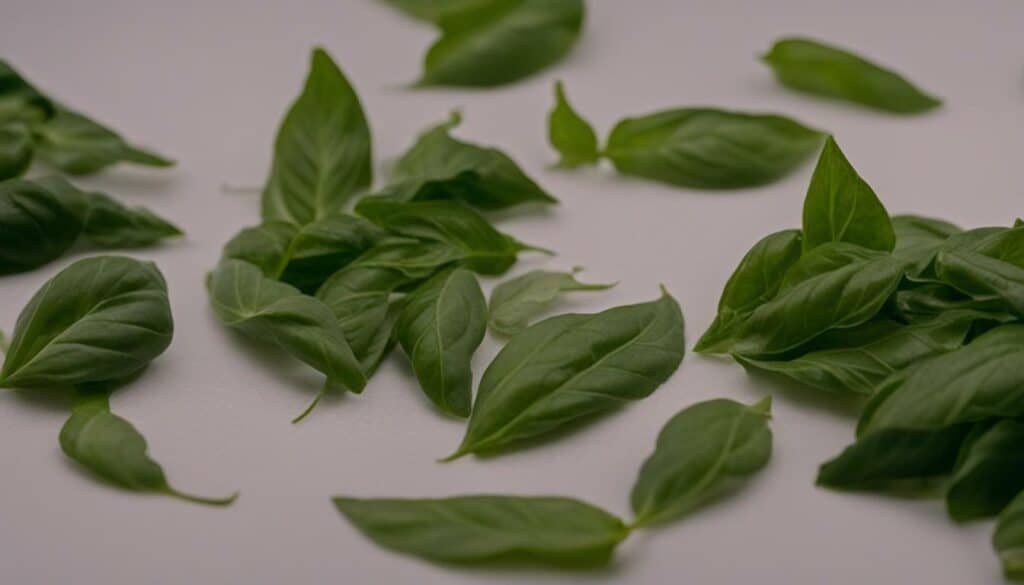
Use Blanching and Freezing for Long-Term Storage
Another method for storing basil is drying it for long-term use as a dried herb, but another option is to blanch and freeze the basil leaves. Blanching involves boiling the basil leaves for a short period, then quickly cooling them in ice water to stop the cooking process. This method helps to preserve the color and flavor of the basil.
To blanch and freeze basil, start by washing the leaves and removing any stems. Bring a pot of water to a boil and prepare a bowl of ice water. Drop the leaves into the boiling water for 2-3 seconds, then transfer them to the ice water to cool for 2-3 minutes. Drain the leaves and place them on a paper towel to dry.
Once the leaves are dry, you can place them in a freezer-safe container or bag and store them in the freezer. Frozen basil can be easily added to soups, stews, sauces, and other dishes, adding a burst of fresh flavor even in the dead of winter.
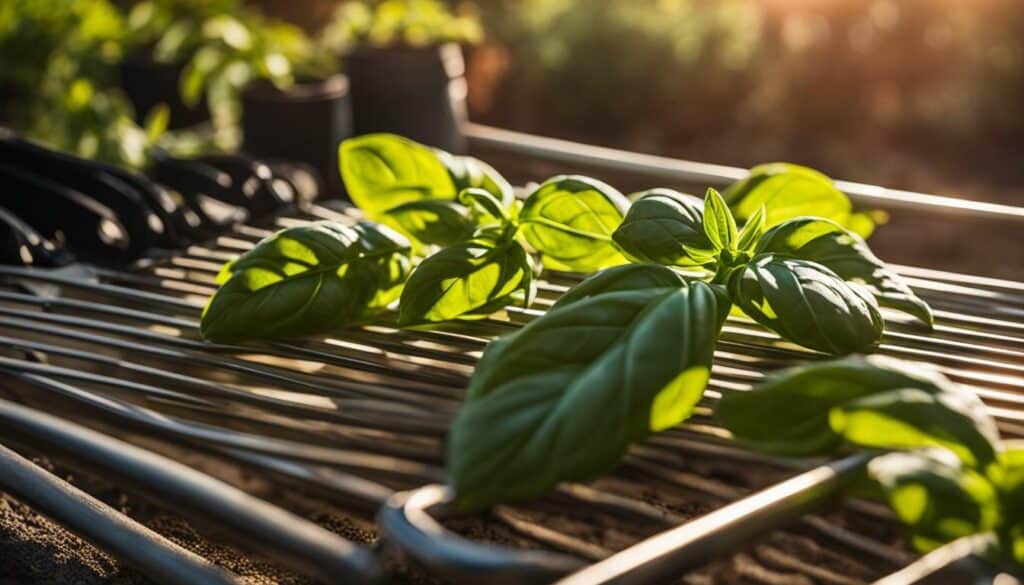
Whether you choose to dry or freeze your basil, both methods are great for preserving the flavor and aroma of the herb for long-term use. Experiment with different methods to find the one that works best for you and your cooking needs. With proper storage techniques, you can enjoy your homegrown basil all year round.
Overall Benefits of Proper Storage Techniques
Overall, proper storage techniques can help you enjoy fresh basil from your garden for longer periods. Properly stored basil retains its aroma and flavor, making it ideal for use in a variety of dishes. Additionally, practicing proper storage techniques reduces food waste and saves money, as you won’t have to buy fresh basil as often.
Preserving herbs from the garden is a great way to enjoy the benefits of fresh produce year-round. Storing fresh basil is easy with the different methods outlined in this article. Whether you choose to store the basil in water, freeze it, or dry it for long-term use, you can extend its shelf life and enjoy the delicious flavor of this versatile herb.
By storing fresh basil properly, you can ensure that it stays fresh, flavorful, and fragrant for an extended period. Don’t let your harvest go to waste. Try out these different storage methods and get creative with how you use your fresh basil.
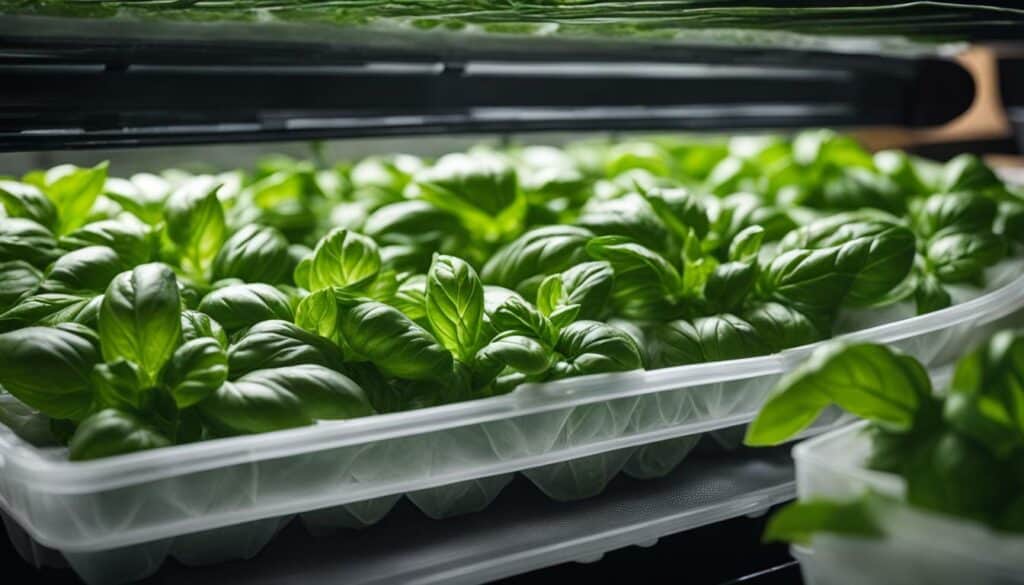
What Is the Best Method for Storing Fresh Basil from the Garden?
Successfully storing fresh basil from the garden requires a reliable method. One popular approach is freezing the basil leaves in ice cube trays filled with water or olive oil. Another effective method is drying the leaves by hanging them upside down in a warm, well-ventilated area. Whichever method you choose, ensure the basil is thoroughly clean and dry before storing to maintain its flavor and aroma.
Conclusion
In conclusion, by following the recommended methods such as water storage and using basil for homemade sauces, you can maximize the freshness of basil from your garden. Trimming the stems and placing them in a vase with water is a simple yet effective way to keep basil fresh for up to a week or more. Storing basil leaves in a jar or container with water and covering them with a plastic bag like a bouquet of flowers is another excellent option. Freezing basil is also possible, but blanching the leaves in boiling water and placing them in an ice bath before freezing is recommended. Making basil cubes is also a great option. Finally, drying excess basil can help extend its lifespan and provide you with a flavorful herb to use as a garnish or in dishes. Overall, these storage methods can help reduce waste and allow you to enjoy fresh basil for a longer period.
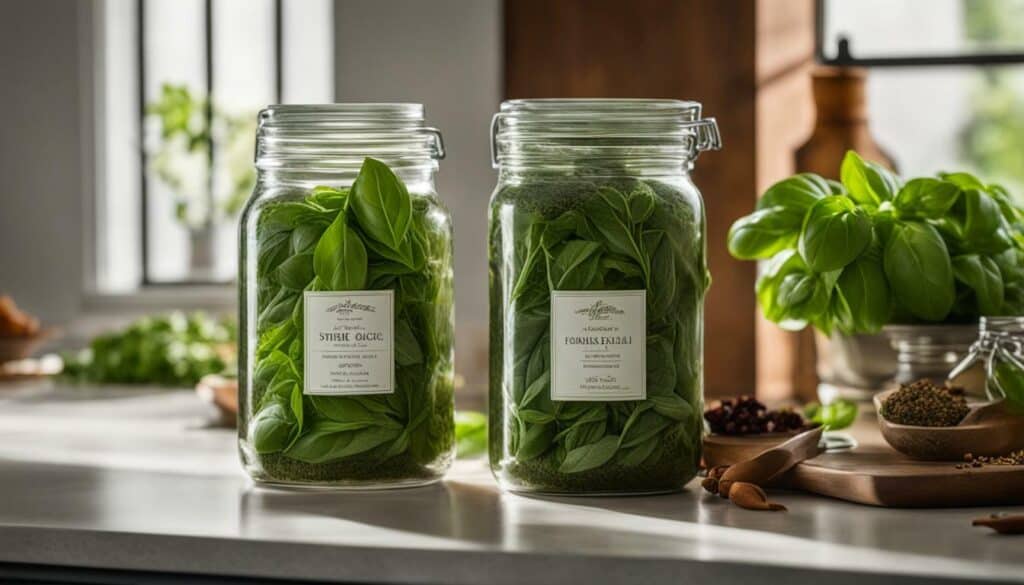
Additionally, experimenting with different storage methods and finding what works best for you can further enhance your basil storage techniques. Here are a few more tips:
– Wrap individual basil leaves in a damp paper towel and store them in a resealable bag in the fridge for up to a week.
– Make sure your basil leaves are completely dry before storing them to prevent mold growth.
– Avoid storing basil near ethylene-producing fruits and vegetables, as this can cause the leaves to wilt and decay.
– Use airtight containers to prevent moisture and air from getting in and causing spoilage.
– If you’re short on time, consider using a food dehydrator to quickly dry basil for later use.
By taking the time to properly store your basil, you can enjoy the fresh and flavorful taste of this herb all year round. Try out different methods and see what works best for you, and don’t be afraid to get creative with your preservation techniques. Happy cooking!
FAQ
Q: What is the best way to store basil from my garden?
A: One recommended method is to trim the ends of the basil stems and place them in a glass jar or vase filled with water. Cover the basil loosely with a plastic bag and keep it at room temperature, changing the water every two days. This can help the basil last for up to a week, with fresh leaves readily available.
Q: Can I refrigerate basil?
A: It’s best to avoid refrigeration as cold temperatures can cause basil to turn black and mushy.
Q: Can I freeze basil for long-term storage?
A: Freezing basil is not recommended as it can lose its vibrant color, fresh flavor, and tender texture. Instead, consider making sauces like pesto or chimichurri to extend the life of the herbs. Another way to store basil is by treating it like a bouquet of flowers. Trim the stems, place them in a jar of water, and cover the leaves loosely with a plastic bag. This method can keep basil fresh for up to two weeks. Additionally, you can blanch basil leaves and freeze them for long-term storage.
Q: How else can I store basil?
A: You can also use paper towels to keep the leaves dry and wrap them in an airtight container in the refrigerator. Another option is drying the basil for use as a dried herb.
Q: What are the benefits of proper storage techniques for fresh basil?
A: Proper storage techniques can help you enjoy fresh basil from your garden for longer periods, ensuring its freshness and allowing you to have readily available herbs for cooking.
Q: Are there any additional tips for basil storage?
A: Overall, it’s important to keep basil away from cold temperatures and avoid refrigeration. Using water storage, making sauces, treating basil like a bouquet of flowers, blanching and freezing, using paper towels and airtight containers, and drying the basil are all effective storage methods to consider.
Source Links
- https://www.cleaneatingkitchen.com/how-to-store-fresh-basil/
- https://www.themediterraneandish.com/how-to-store-fresh-basil/
- https://www.bonappetit.com/test-kitchen/inside-our-kitchen/article/how-to-store-basil
- https://food52.com/blog/27295-how-to-store-basil
- https://www.reddit.com/r/AskCulinary/comments/xlqiub/how_to_store_and_keep_picked_basil_fresh_and_green/
- https://www.epicurious.com/expert-advice/how-to-store-fresh-basil
- https://www.lacademie.com/how-to-store-fresh-basil/
- https://getbusygardening.com/storing-basil/
- https://www.platingsandpairings.com/how-to-freeze-basil/
- https://anoregoncottage.com/freezing-basil-leaves-6-ways/
- https://www.allrecipes.com/article/how-to-store-and-preserve-fresh-basil/
- https://www.homemademastery.com/how-to-dry-basil-leaves/
- https://urbanfarmie.com/how-to-dry-fresh-basil-leaves/
- https://www.alphafoodie.com/how-to-dry-basil-leaves/
- https://www.savorysuitcase.com/how-to-store-fresh-basil/
- https://cookplantmeditate.com/2012/05/16/how-to-store-basil-an-experiment-2/

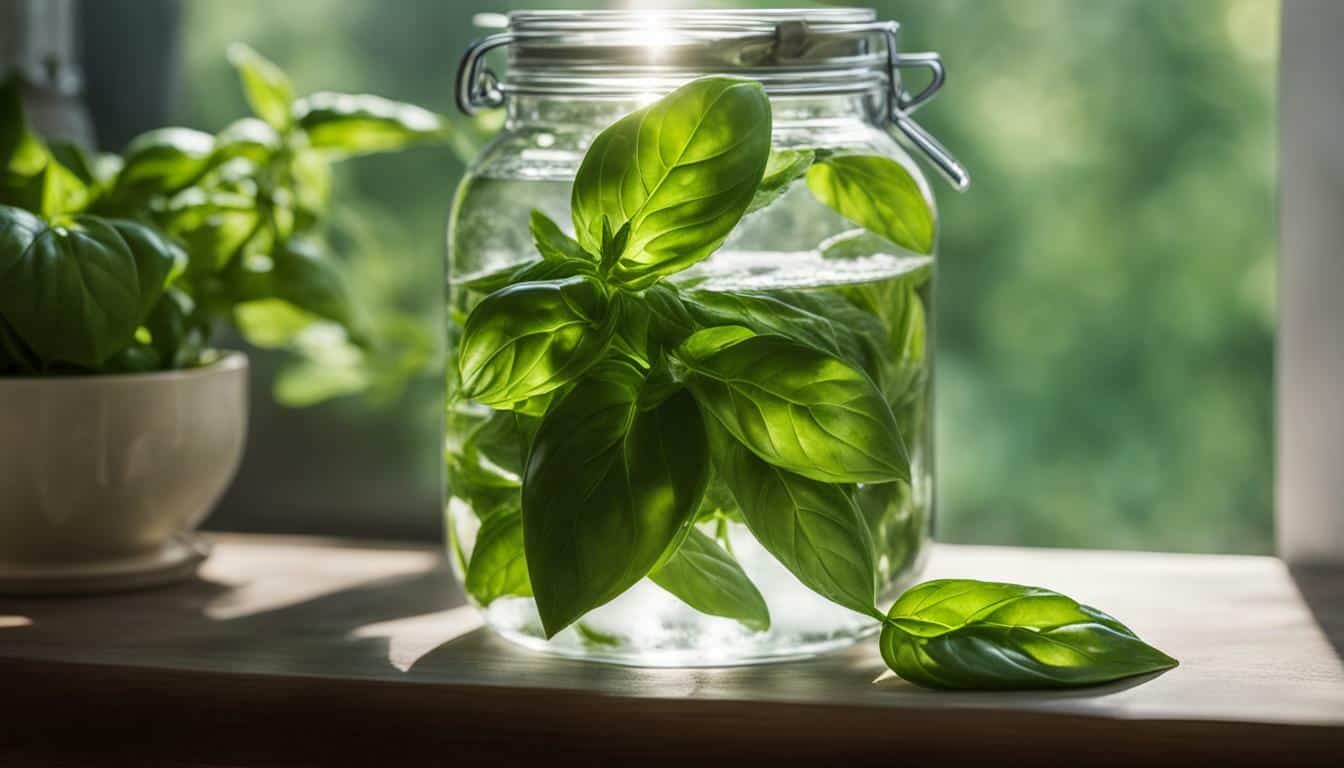



Leave a Reply